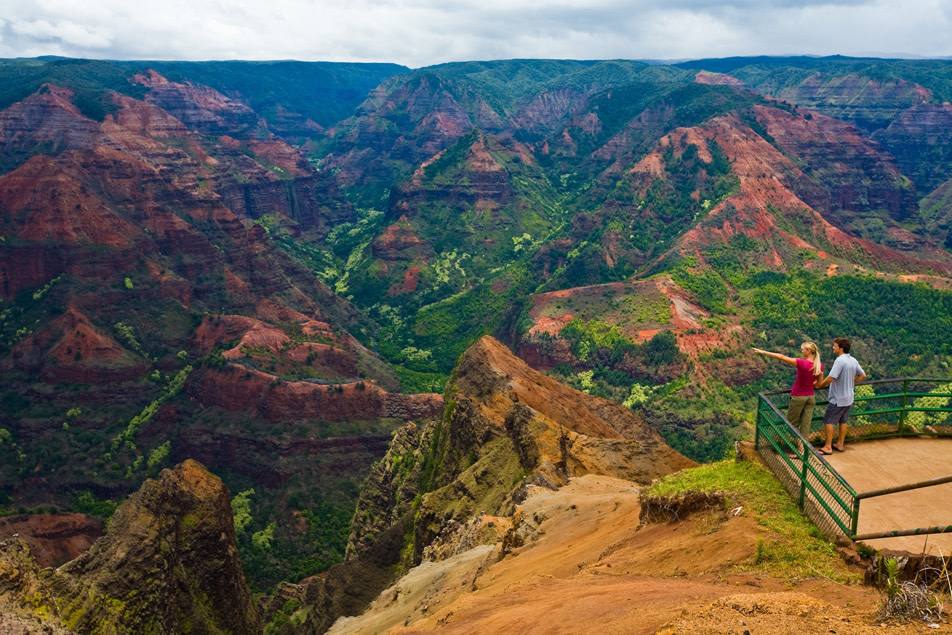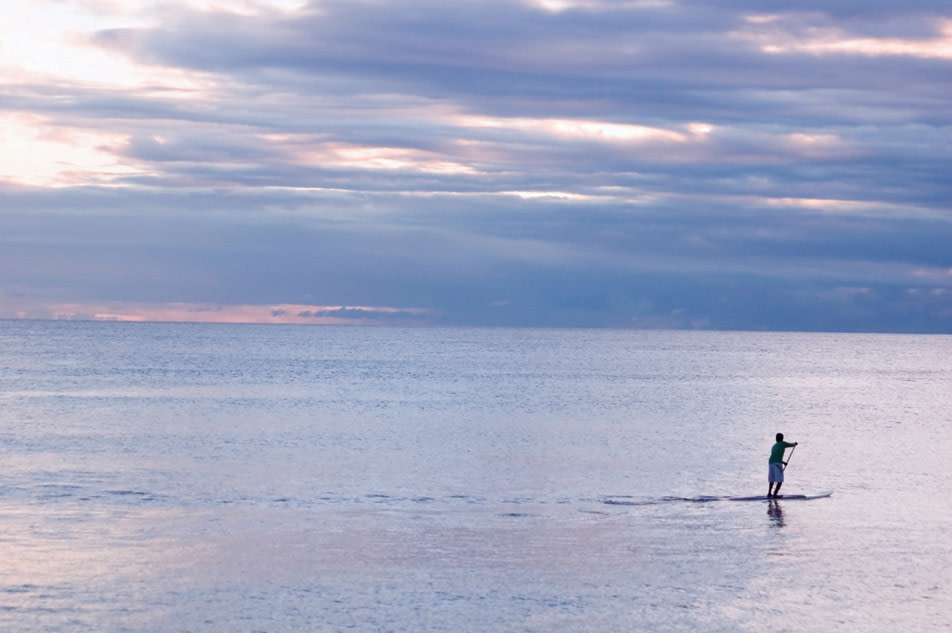Paradise Found

The island’s famed Waimea Canyon plunges 3,600 feet.
OUR FIRST HIKE ON KAUAI began innocently enough: we crossed a small wooden bridge onto the Okolehao Trail, which led to a 1,250-foot peak on the north shore of the island. In just an hour’s time, we’d reached the log bench that presided over a stunning view of the north shore.
Technically, this was the end of the hike. But considering that my longtime friend Birch and I had just flown five hours from Los Angeles for a week away from the urban grind, we weren’t ready to end our excursion.
We’d heard about an extension trail that led from here to the 2,400-foot-tall Hihimanu, one of the peaks that towers over the surf hamlet of Hanalei. We followed the red-clay path west through wispy lilyturf grass and sharp-leafed laua’e fern, native flora that helped obscure the fact that the trail traced a knifelike ridge with a stomach-flipping 300-foot drop on each side. Using a series of knotted ropes tied to trees, we eventually hauled ourselves up a slick, nearly vertical stretch of earth, grunting and sweating our way through exclamations such as “I feel like Indiana Jones!” After three hours, we stood—muddy, exhausted, elated—on top of Mount Hihimanu. From there we could see a third of Kauai’s 553 square miles. To the north was Hanalei Valley, blanketed in ancient taro paddies (the tubular plant that forms the backbone of the traditional Hawaiian diet), and to the south, on the back side of Hihimanu, an expansive rain forest extended all the way to the Pacific.
Kauai is the most spectacular and rugged of Hawaii’s main islands and remains relatively untouched by high-rise hotels and the frozen-umbrella-drink set. This is largely because its vertiginous mountains make 90 percent of the island inaccessible by car. The coast is dotted with just a handful of towns, and only around 60,000 people live on the island full-time (compare this to Oahu’s 876,000). The island’s relative emptiness and freedom from mass development have allowed Kauaians to protect its primordial forests, ubiquitous waterfalls, fifty miles of beaches, one hundred miles of red-clay hiking trails, and Waimea Canyon, 3,600 feet deep. All this is lucky for Hollywood location scouts, who often rely on Kauai for its fantastical backdrop: Jurassic Park, Raiders of the Lost Ark, and 1976’s King Kong were all filmed here.
When Kauai isn’t doubling as a playground for velociraptors or gorillas, “It’s the island where people come for adventures,” says Boreas Van Nouhuys, a thirty-six-year-old San Francisco transplant and volunteer guide for the Sierra Club, who, on the following day, led me, Birch, and five others on an East Shore hike of the Makaleha Trail. I noticed the locals in our group were wearing hoof-shaped rubber slippers with tiny spikes on the soles, called tabis. As we hiked from the green shade of a bamboo forest across a river, I felt my tabi-lessness acutely: my sneakers failed to grip the river rocks and I slipped waist deep into the chilly water.

Image: Dick Goerg,Dick Goerg
Soon we entered a valley brimming with waterfalls. “Kauai has thirty-three different microsystems,” Karen Tilley, an off-duty Sierra Club leader, said as we climbed over tree branches slick with moss. Like all Kauaians, Tilley is passionate about protecting her home from the commercialism that has overtaken Maui and Oahu. I’d noticed that Kauai had successfully fended off sprawl while still allowing for a handful of resorts, housing developments, and intimate restaurants to flourish. I found out later that Kauai’s protectionist spirit dates all the way to 1796, when King Kamehameha of the Big Island sent ten thousand troops to invade its tiny neighbor; eventually Kauai’s king, Kaumualii, surrendered to Kamehameha in 1810.
After our hike, Birch and I drove to the trailhead to check out the Queen’s Bath, a ten-foot-deep tidal pool just east of Hanalei in the town of Princeville. A quarter-mile hiking path dumped us out at the ocean, and we walked ever carefully on the jagged black volcanic rock, arriving just in time to see two daredevils launching off the fifteen-foot-high rocks above the tide pool. We jumped in, too, and swam around in what felt like a giant eighty-degree aquarium—we saw a sea anemone, a couple of blue-eyed damselfish, and a school of sergeant majors.
After a few days of rest at Hanalei Colony Resort, we ventured by car five miles east to Hanalei Bay, home to Kauai’s best surfing. Though Birch and I had surfed before, we signed up for a practice lesson and a session of stand-up paddleboarding with Hawaiian Surfing Adventures. On the yellow-sand beach of Hanalei Bay, we got a quick refresher on technique, stretched, and then bellied onto our boards. Despite the morning’s (relatively) calm conditions, we caught at least a dozen waves. Between swells, I lay on the board and gazed up at the sky and at the mountainous cirque beyond the beach. From here, Mount Hihimanu, the scene of our treacherous first hike, looked almost benign above a stand of casuarina trees, which shaded a Jack Johnson sound-alike strumming a guitar.
For the first time since we arrived, I realized that Kauai had another, more tranquil side. I wasn’t hiking, paddling, swimming, or exploring, but simply letting the island’s mesmerizing peacefulness wash over me.




